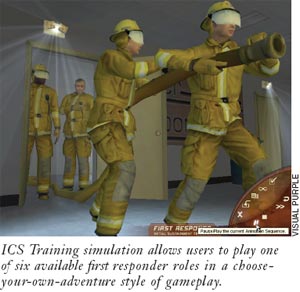Virtual-World Emergency Training
One size fits all works for some clothing, but not for incident command training.
- By Marc Barrera
- Jan 02, 2008
 In 2004, the U.S. Department of Homeland Security, under presidential order, instituted the National Incident Management System. This nationwide initiative was targeted at getting federal, state, tribal, and local governments to work together to prepare for, prevent, respond to, and recover from domestic incidents, such as terrorist attacks or natural disasters.
In 2004, the U.S. Department of Homeland Security, under presidential order, instituted the National Incident Management System. This nationwide initiative was targeted at getting federal, state, tribal, and local governments to work together to prepare for, prevent, respond to, and recover from domestic incidents, such as terrorist attacks or natural disasters.
One of the requirements for compliance was that these authorities had to institute Incident Command System training across all of their emergency services, such as EMS, fire service, law enforcement, and other emergency management response departments, in preparation for becoming FEMA-certified in ICS/IS levels 100 and 200. But the comprehensive nature of this training presented unique obstacles for many emergency services to tackle: How do you individually train someone to work not only in a team, but as part of a group of coordinating agencies? Does learning from a three-ring binder or traditional classroom setting have a realistic chance of success?
Wearing Many Hats
In answer to such questions, the new 3D simulation ICS Training Series training tool from California-based Visual Purple has taken instruction off the page and placed it in a simulated real-world environment that puts the user in the middle of the action. No matter which department they work in, users can choose to play the training simulation in any one of six available first responder roles—Fire Chief, Police Chief, EMS Chief, EMA Chief, Hazmat Chief, and Public Health Officer.
In addition, the simulation employs a choose-your-own-adventure style of gameplay. “No matter what type of first responder they are, whether it’s fire, police, hazmat, or public health, they’re not only learning their own role in an incident, but they’re also learning the role of other first responders,” said Megan Rutherford, business development director. “It brings a kind of a real-world interaction that they normally wouldn’t get unless they were in an actual incident.”
The series features three simulations, supplemented with PDF documents that users can access and print as they become relevant, that take place in the fictional small town of Belserville. At various points in the simulations, users are presented with choices on the best course of action to take. These choices will depend on the character the user has chosen, and the user’s responses can result in a variety of outcomes. “There’s no right or wrong answers, necessarily,” Rutherford said. “A lot of the questions are just determining what they would do in an actual incident. Basically, we like to refer to it as awareness-level training.”
The first simulation is the longest of the three. Titled “ICS: Foundations,” it is designed to prepare the user for ICS level 100 certification. In it, all of the first responder characters are gathered around a conference table interacting with a WMD expert as he gives a presentation on all possible threats and hazards the group may face.
The second simulation, “ICS: Plan For Action,” is the first part of the series ICS level 200 instruction. It picks up immediately where the players previously left off and begins walking them through the process of creating a response plan.
The last simulation, “ICS: Call To Action,” wraps up the ICS level 200 training by having all of the previous lessons come into play in a real-time scenario in which all characters must work together to respond to a fire at a chemical factory that could have dire consequences for the surrounding community.
Low Cost and Portability
Beyond its ability to deliver instruction through many different hats, the tool has other benefits in its favor. Rather than spending as much as $20,000 to pay someone to train your staff, plus covering the cost of lost work hours, clients can purchase the product for $59.99 per user license (up to nine), Rutherford said. For 10 to 99 licenses, the price drops to $49.99 each. User licenses last five months but can be renewed for an additional seven months for $9.99 each.
Portability is a second benefit—because the tool is completely browser-based and there is no equipment to buy, users can learn at their own pace around their often erratic schedules, Rutherford said. “On their downtime, while they’re waiting on their next call, they can just go online and play for an hour, save the game, and then come back to it at a later time. So, it’s not something that they have to sit down and allot the whole eight hours of time to do. They can do this at the firehouse, they can do this at home, et cetera.”
For more information or to view online demos, visit www.visualpurple.com.
This article originally appeared in the January 2008 issue of Occupational Health & Safety.